How to make a gas generator with your own hands: features of manufacturing a homemade device
A gas generator is an apparatus for producing gas from coal, firewood, woodworking waste and other materials. Generated fuel can replace traditional hydrocarbon fuel - natural gas for heating homes and gasoline for a car.
The main idea of using such a unit is to save on fuel costs. The constant rise in price of gasoline, propane and methane makes home craftsmen look for alternative ways to get fuel.
To make a gas generator with your own hands, you need to understand its structure and principle of operation.
We will explain how the conversion of solid fuel into combustible gas occurs, designate the design features of the unit and give examples of self-assembly of simple devices. For better assimilation of information, we supplemented the article with visual diagrams, photographs and video clips.
The content of the article:
Gas generator: device and principle of operation
A gas generator is a device that converts liquid or solid fuel into a gaseous state for its further combustion in order to obtain heat.
Fuel Options for a Generation Unit
Units operating on fuel oil or mining have a more complex structure than models using various types of coal or firewood.
Therefore, it is most often solid propellant gas generators that are found - since the fuel is affordable and cheap for them.
As a solid fuel in a gas generator use:
- charcoal, brown and hard coal;
- fuel pellets from wood waste;
- straw sawdust and firewood;
- peat briquettes, coke;
- the husk of the seeds.
Particularly thrifty owners harvest their own sawdust briquettes.
Gas generation is possible from all these types of fuel. Energy release depends on calorific values of different types of fuel.
Moreover, the heat from the combustion of raw materials in the gas generator is obtained more than from the use of solid fuel in boilers. If the efficiency is normal wood boiler varies in the range of 60–70%, then in the gas generator complex the indicator reaches 95%.
But here we must take into account one caveat. The boiler burns fuel to heat water, and the gas generator only produces fuel. Without a heater, stove or ICE, the sense of a homemade gas generator will be zero.
The resulting gas should be used immediately - it is economically unprofitable to accumulate it in any tank. To do this, you will have to install additional equipment, depending on the power supply.
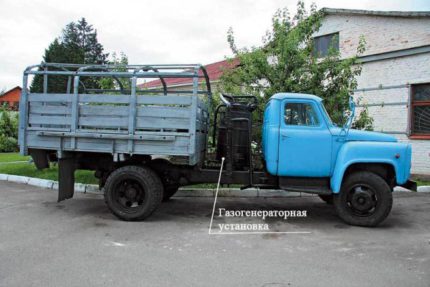
What happens inside the gas generator
The operation of the gas generator is based on the pyrolysis of solid fuel, which occurs at high temperatures and low oxygen content in the furnace. Inside the gas generating device, several chemical reactions occur simultaneously.
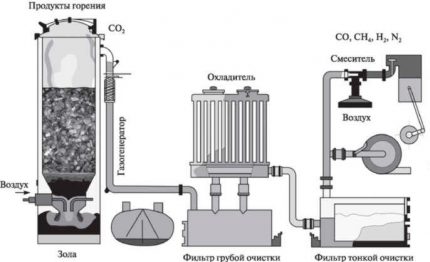
Technologically, the process of generating combustible gas is divided into three successively occurring stages:
- Thermal decomposition of fuel. The process proceeds in conditions of oxygen deficiency, which is supplied to the reactor only a third of the required for normal combustion.
- Purification of the resulting gas. In a cyclone (dry vortex filter), a gas cloud is filtered from volatile ash particles.
- Cooling. The resulting gas mixture is cooled and subjected to additional purification from impurities.
In fact, in the gas generator unit as such, it is the first process that occurs - pyrolysis. All the rest is the preparation of the gas mixture for further combustion.
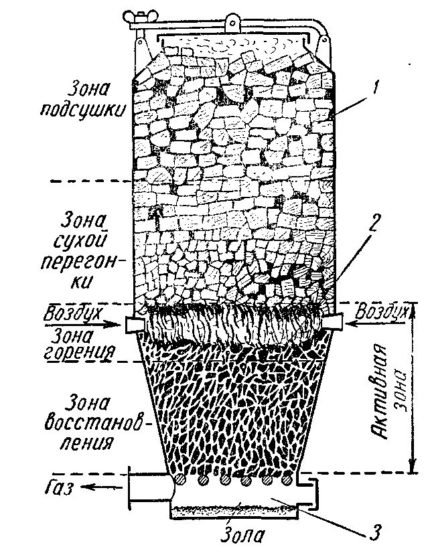
At the exit of the gas generating unit, a combustible mixture of carbon monoxide, hydrogen, methane and other hydrocarbons is obtained.
Also, depending on the fuel used in the pyrolysis, water in the form of steam, oxygen, carbon dioxide and nitrogen are added to them in various amounts. According to the described principle, they function and pyrolysis heating boilersshowing high efficiency.
Features of the various converters
Gas generators for the device and technology of internal processes are:
- straight;
- Converted
- horizontal.
They differ in the points of air supply and output of the generated gas.
Direct process occurs when the air mass is injected from below and the exit of the combustible mixture at the top of the structure.
Inverted Option involves the supply of oxygen directly to the oxidation zone. At the same time, it is the hottest in the gas generating device.
It is quite difficult to independently inject it into it; therefore, this principle of operation is applied only in industrial plants.

AT horizontal gas generator the outlet pipe with gas is located immediately above the grate in the zone of combining oxidation and reduction reactions. This design is the simplest in independent execution.
Advantages and disadvantages of gas generators
A factory-made household gas generator will cost 1.5–2 times more expensive than a conventional solid fuel boiler. Is it worth it to spend money on this “miracle technique”?
Among the advantages of using gas generators are:
- complete burnout of fuelloaded into the furnace, and the minimum amount of ash;
- relatively high efficiency when working with ICE either gas boiler;
- wide selection of solid fuels;
- ease of operation and the lack of the need to continuously monitor the operation of the unit;
- time interval between reboots firebox - up to a day on wood and up to a week on coal;
- the possibility of using raw wood - wet raw materials can be used only in some models of gas generators;
- environmental friendliness of the device - this device does not have an exhaust pipe, all the generated gas goes in direct flow to the combustion chamber of the engine or boiler.
When using wet firewood, the generator will work, but the gas production will be reduced by 20–25%. The decline in performance is due to the evaporation of natural moisture from wood.
This leads to a decrease in temperature in the furnace, which slows down the pyrolysis process. It is best to dry the logs thoroughly before loading them into the pyrolysis chamber. Industrial devices are fully automated, fuel is supplied to them by a screw from a nearby container.
A self-made gas generator does not please with such autonomy, but it is also quite simple to operate. It is only necessary from time to time to load it with fuel to the eyeballs.
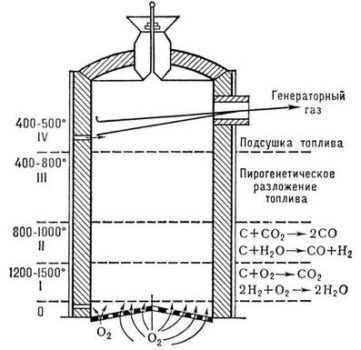
The gas generator has fewer disadvantages, but they are:
- poorly regulated gas volumes - when the temperature in the furnace decreases, the pyrolysis stops and instead of a combustible gas mixture, a mash of resins forms at the outlet;
- bulkiness of installation - even a home-made gas generator of average power of 10-15 kW takes up a fairly large space;
- kindling time - before the reactor produces the first gas, it will take 20-30 minutes.
After “warming up” the generator stably produces a certain volume of the gas mixture, which must be burned or thrown into the air. To make this unit with your own hands you will need durable gas cylinders or thick steel, and this is a lot of money. But all this pays off with the economics of the generator and the low cost of the initial fuel.
Some models of gas generators are equipped with an air blower, while others are not. The first option allows you to increase the capacity of the installation, but it ties it to the mains. If you need a small generator for cooking outdoors, then you can do a compact unit without an air supercharger.
Most self-made gas generating units operate by natural traction.

To heat a private house, you will need an already more powerful and volatile device. However, in this case, it is worth taking care of the backup power generator, so that overnight in the event of an accident on the network, you will not be left without power supply or without heating.
Work units of a homemade unit
To figure out how you can make solid fuel gas generator do it yourself, you need to clearly imagine its design. Each of the elements has its own purpose, even the absence of one of them is unacceptable.
Inside the housing of a homemade gas generator should be present:
- solid fuel hopper at the top of the unit;
- pyrolysis chamber, where the smoldering process takes place;
- air distribution device with check valve;
- grate with an ash pan;
- outlet pipe for produced gas;
- cleaning filters.
In a home-made generator on wood, a fairly high temperature is formed, therefore, strict requirements are imposed on each of its elements. For the case, durable sheet steel is used, and all parts inside are selected as heat-resistant as possible.
To ensure the tightness of the fuel loading hatch in the closed state, the lid will need a sealant. The cheapest material for this is asbestos. However, it is not harmless to human health; it is better to find special heat-resistant gaskets based on silicones or silicates in the store.
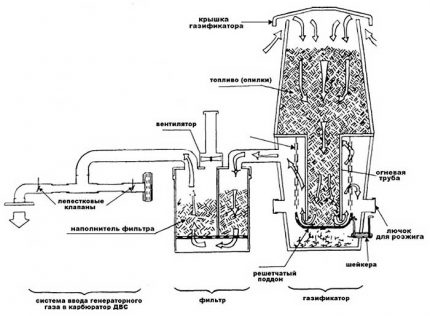
The body can be either cylindrical or rectangular. To simplify the work, a couple of cylinders for natural gas or iron barrels are often taken. One of the grid-irons at the bottom of the firebox is welded “tightly”, and the second is built in so that it can be moved. This is necessary to clean them of slag and ash.
The air distribution unit is located outside the housing. It provides the necessary volumes of oxygen to the furnace, but due to the non-return valve, it does not release combustible gases from it.
Gas generator manufacturing technologies
There are several ways to make a gas generating system yourself. The choice here depends on the availability of materials and the further use of the resulting gas.
Option # 1: An example of building a coal-fired apparatus
Consider an example of making a useful homemade product from a metal bucket with a lid. First, we will prepare the unit, which will process the gas received from the installation into electricity.
After preparing the consumer for the upcoming operation, it is possible to engage in the construction of a gas generator directly.
The branch pipe that exhausts gas from the installation must be equipped with a filter, as in the process of combustion, coal emits a lot of fine suspension and dust.
Having completed the process of constructing a makeshift gas generator, it is necessary to check its operability.
Option # 2: Gas generator from two-hundred-barrel drums
For a home-made barrel gas generator, you need a pair of tanks of 200 liters. One of them is inserted into the other two-thirds.
The space formed below will be used as a combustion chamber, and the upper part will ideally fit a firewood bin or pellet.
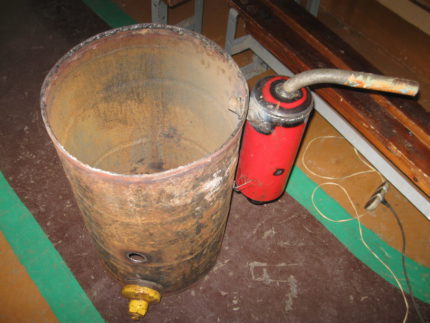
On the side, at the level of the pyrolysis section, a pipe with a cross section of 50 mm is welded to pump air, and closer to the lid is a gas outlet pipe. A hole is cut out in the bottom of the inner barrel for fuel to enter the combustion chamber, and a blower door is attached to the bottom of the outer barrel.
It remains only to make filters for cleaning the gas mixture before transferring it to the boiler. For this you will need used fire extinguishers or pipe sections of a similar size.
From above, they are tightly closed, and from below, a cone nozzle is welded, at the end of which there is a fitting for removing ash. Then, a nozzle is inserted into the side for supplying the gas mixture for cleaning, and an outlet for already filtered gas is inserted into the lid.

Further, to lower the temperature of the combustible gas, a cooling radiator is made of several pipes with a diameter of 10 cm. They are connected to each other by small pipes.
For the final gas purification, another filter is installed with expanded clay, small metal washers or sawdust inside.The use of the latter material is permissible only provided that the incoming gas has already cooled, otherwise the matter may reach a fire.
It will turn out to make a “potbelly stove” from a gas cylinder. Instructions for creating a primitive furnace are given in this article.
Option # 3: Homemade ICE Model
For a car or motorcycle, a homemade gas generator is made according to a similar scheme. Only here you will have to reduce the installation size to a minimum. Carrying a heavy unit is unprofitable, and it does not look very aesthetically pleasing.
To make your job easier, for the automotive version of the generator, it is best to take gas cylinders. The main thing is to make sure before welding that there is no hint of the presence of propane in the tank, otherwise a small explosion may occur. To do this, unscrew the balloon valve and fill the container to the eyeballs with water.
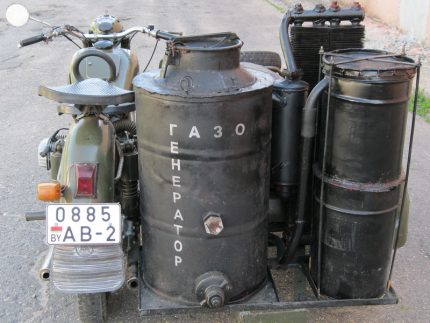
Initially, an automobile gas generator produces too hot gases. They must be cooled without fail. Otherwise, in contact with the hot parts of the engine, they may ignite spontaneously. In addition, the heated gaseous fuel has a low density, which is why it is simply problematic to set it on fire in the cylinders.
A home-made gas generator for a car can be mounted in the trunk or on a trailer.
The second method is preferable due to:
- ease of repair;
- the ability to leave a gas generating unit in the garage;
- the availability of free space in the trunk;
- the possibility of using the installation for other needs in addition to supplying fuel to the internal combustion engine.
Do not be afraid of road bumps. When bouncing on bumps, the solid fuel in the combustion chamber will be shaken, which will only contribute to its better mixing and combustion.
The nuances of the operation and operation of gas generators
It is important to remember that the gas produced by the installation is odorless and poisonous. If mistakes are made when welding metal parts of the gas generator with your own hands, then trouble can not be avoided.
For a natural air flow in the combustion chamber, 5 mm holes can be drilled around the circumference of the housing. All installation work and performance checks should be carried out in a well-ventilated workshop or on the street.
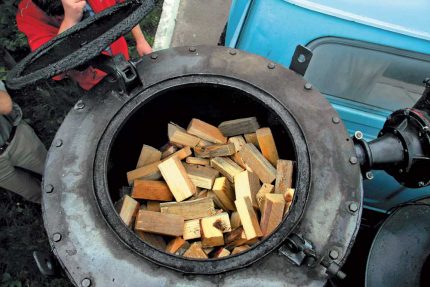
After ignition, the shutter is closed to limit the flow of oxygen into the combustion chamber. In order for the self-made gas-generating system to work properly, it is necessary to correctly adjust the outlet of the resulting gas mixture and the oxygen supply.
Before starting to tinker with a gas generator, engineering calculations should be made, in which it is necessary to take into account the combustion area and type of fuel, as well as the required output power and the expected mode of operation.
Conclusions and useful video on the topic
How to use a charcoal processing gas generator as a fuel supplier for a small car:
Simple gas generator from propane cylinders:
The device of a wood gas generator:
The above methods are suitable for self-production of an effective gas generator. But there are many more models of this device. Some of them are easier to make, others are more complicated.
The main thing when assembling the unit is to pay maximum attention to the quality of the welds, otherwise gas leaks and an explosion can occur. If everything is done correctly, then the gas generator will regularly serve 10-15 years. And then the metal of the case starts to burn, and you have to do everything anew.
Do you have practical assembly skills or experience using a homemade gas generator? Please share your knowledge and ask questions about the topic in the comments below.

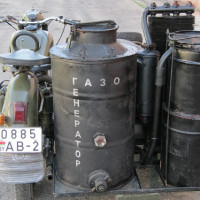 How to make a wood-based gas generator with your own hands: homemade wood and sawdust
How to make a wood-based gas generator with your own hands: homemade wood and sawdust 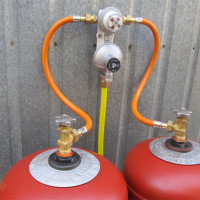 Gas cylinder ramp: device + DIY manufacturing example
Gas cylinder ramp: device + DIY manufacturing example 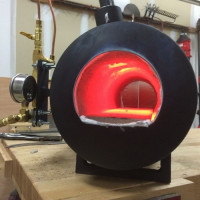 How to make a blacksmith forge on gas with your own hands: tips + drawings to help home craftsmen
How to make a blacksmith forge on gas with your own hands: tips + drawings to help home craftsmen  How does a thermal blanket work for gas cylinders: features of the device and use + selection tips
How does a thermal blanket work for gas cylinders: features of the device and use + selection tips  Disconnecting devices on gas pipelines: types of valves and the features of its installation
Disconnecting devices on gas pipelines: types of valves and the features of its installation 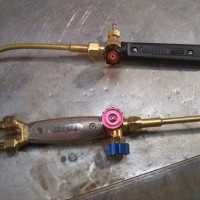 DIY propane gas burner: step-by-step instructions for assembling home-made burners
DIY propane gas burner: step-by-step instructions for assembling home-made burners  How much does it cost to connect gas to a private house: the price of organizing gas supply
How much does it cost to connect gas to a private house: the price of organizing gas supply  The best washing machines with dryer: model rating and customer tips
The best washing machines with dryer: model rating and customer tips  What is the color temperature of light and the nuances of choosing the temperature of the lamps to suit your needs
What is the color temperature of light and the nuances of choosing the temperature of the lamps to suit your needs  Replacement of a geyser in an apartment: replacement paperwork + basic norms and requirements
Replacement of a geyser in an apartment: replacement paperwork + basic norms and requirements
With today's cost of firewood and coal, will gas production be cost-effective? Let's say how many cubic meters of gas can be obtained from a cubic meter of firewood? A cube of sawn and chopped firewood will cost 500 rubles. And the cost of natural gas is about 4 rubles. So, for profitability, the installation should produce at least 200 m3 of gas per cubic meter of wood. Plus explosion hazard in case of leakage. There is something to think about.
In Siberia, the forest is shareware (if you do not get caught for harvesting). Therefore, the gas generator is quite profitable. I thought to buy a store, but the price tag is a bit high. Now I'm looking at how to make a home-made.
Where are industrially manufactured gas generators sold?
You should not consider a gas generator, especially a self-assembled gas generator, which will subsequently have to be modified as a complete replacement for natural and industrial types of gas. If you have access to free production of firewood, coal and other materials used in the gas generator, then you can consider such a project as the main source for gas production. But this is ideal.
Also, do not forget that the gas generator is simply not able to produce propane-butane, which is obtained as a side reaction during the distillation of oil. Actually, in order not to talk about the difference for a long time, I will give a table with different gases and indicators.
To make it clear, comparable with methane, the gas mixture that is obtained in the gas generator. If the resulting gas mixture is pumped into methane cylinders, the car will travel 6 times shorter.
Hello. Recently, I was just reading an article by one craftsman who made a lightweight gas generator with his own hands. He claims that the boiler costs $ 100-200 at cost, and 1 kg of firewood gives 2.2 m3 of gas.
I am an avid fisherman, often get out into the wilderness for a day or more. After reading the article, I immediately wanted something like that. A kind of home-made, portable stove for cooking. Often you sit by the lake, you want a hot one, be it a drink: tea, coffee or lunch. And you don’t want to be distracted by a long ignition of the fire. It will be useful to fishermen, hunters, those who go hiking.
Has anyone tried to use asbestos inside the combustion chamber, something like ceramics or, for example, graphite? After all, as I recall, they are not afraid of temperature, and indeed there is a fireplace mantel 3800 degrees Celsius.